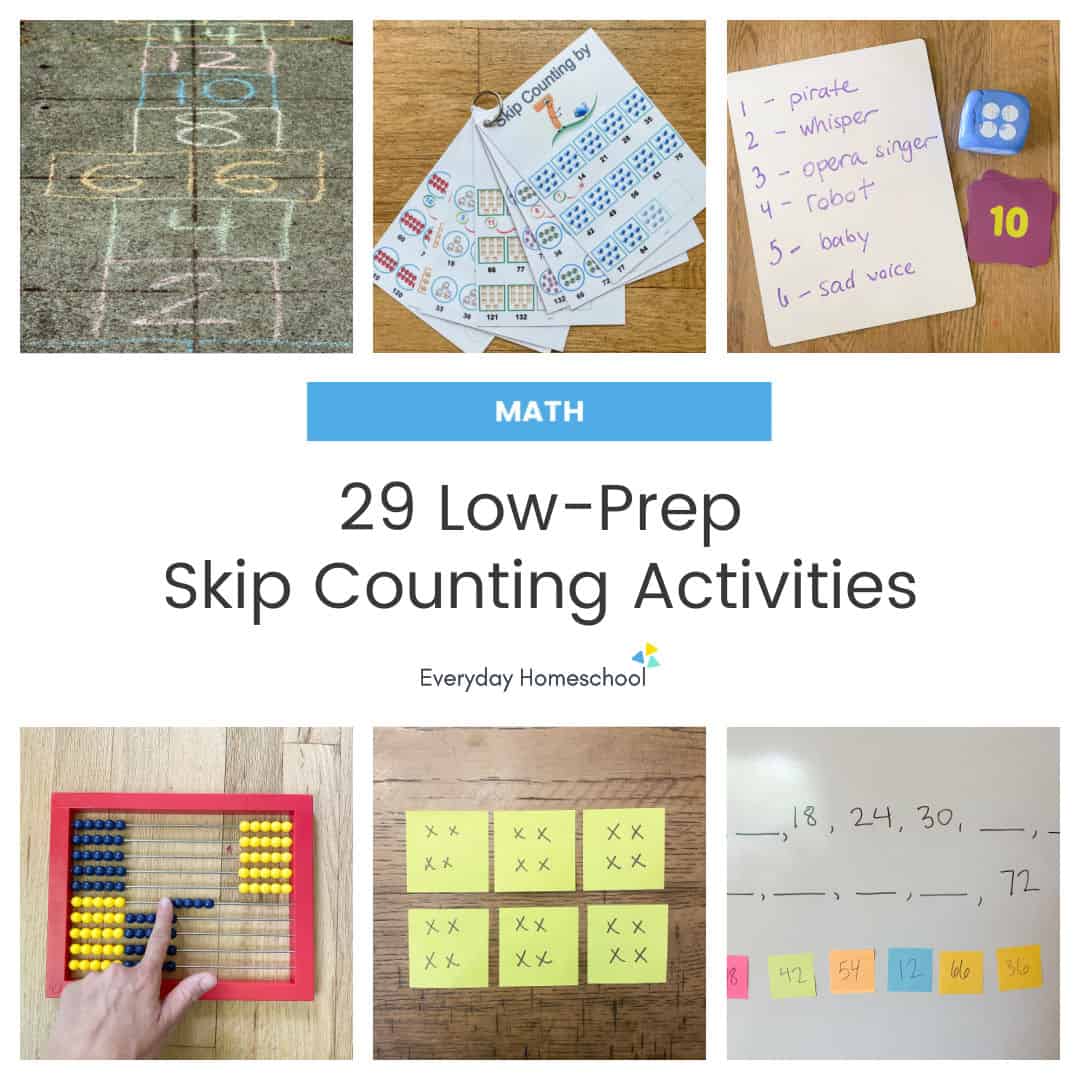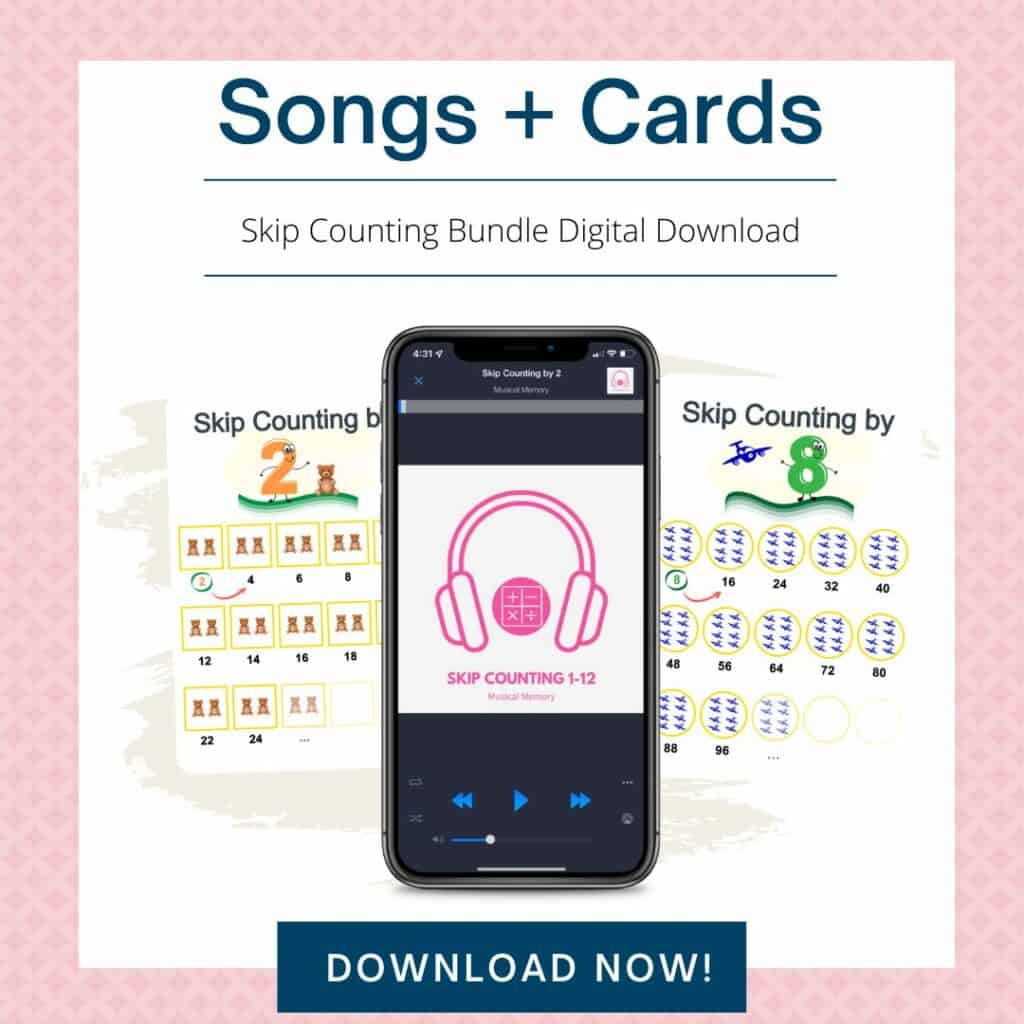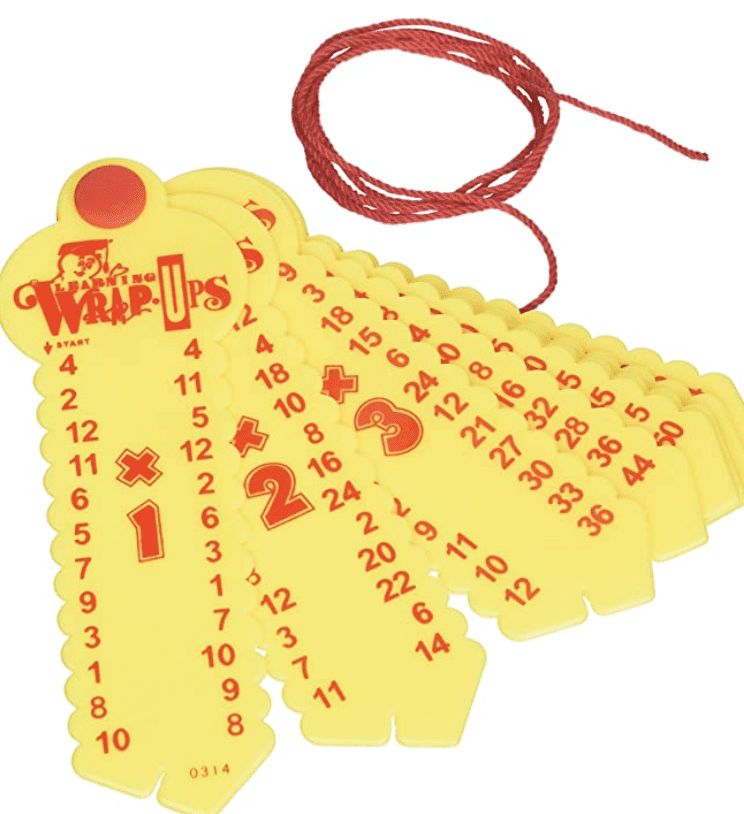This post is full of simple & fun ideas for skip counting activities that you can use to help a child learn & practice skip counting. Plus, I’ve created several free resources & printables that you can download.
Most of the hands-on activities in this blog post can be easily taught. They’re great for recognizing and practicing number patterns. You can have younger students work in a small group on these, or older students can complete many of these games as independent work.
You don’t have to be an expert when it comes to teaching skip counting. All of these are simple and easy to set up too, so let’s dive right in!
Use Tunes First
Using short skip counting tunes to teach skip counting is the fastest way to get the skip counting numbers stuck in the child’s head.
In fact, we mostly just sing these songs to work on skip counting at our house. Then, as skip counting comes up in the math curriculum, we are able to practice the new concepts more easily. (Here are more details on our math songs.)
- Kinder – counting by 10s and 5s for dimes and nickels.
- 1st grade – counting in equal groups; counting 5s on the clock; counting money
- 2nd grade – counting in equal groups; introducing multiplication
- 3rd grade – mastering multiplication facts.
I compiled a giant list of fun skip counting activities (most of which require little to no prep work) for kids and parents who like using this sort of thing for extra practice.
But if you want to keep things super duper simple, just download our songs, hit play, and enjoy the payoff down the road as you start to teach times tables, division problems, factoring, and other math concepts that require a child to skip count quickly.
Once the numbers are in the child’s head, it’s much easier to learn how the skip counting numbers work for counting in equal groups. Our downloadable songs are all 15- 30 seconds long. They’re short, sweet & sticky! And they come with printable cards to help visualize the skip counting.
Concrete, Visual Skip Counting Activities
Math concepts should always be taught in a concrete, visual way FIRST.
Once the child has a few skip-counting songs learned, you can move on to showing how those numbers in the song apply to counting in equal groups.
Once your child knows several skip counting songs from memory AND seems to truly understand the first activity below, he is ready to start practicing other skip counting activities. When the child is ready varies kid-to-kid & could be anywhere between the ages of 5-8.
1. Objects in 2s
Grab 24 items – legos, cars, bingo chips, mini erasers, paper clips, chocolate chips, crackers, whatever! Begin arranging them up neatly in groups of 2. The child will probably “discover” that the items are in groups of 2 and can help you arrange all 24 neatly. This is a great activity for a kindergartener to practice counting by twos.
Count the first 3 groups 1 at a time and show how there are 6 objects. But, if you count in 2s, you can count 2-4-6. There are still 6 objects, you just counted them in groups of 2. Sing the skip counting 2s song your child knows: 2-4-6…. see if the child will continue singing and counting the rest of the groups up to 24.
Tip – Have the child sing slowly so that he can use his finger to point accurately. Careful counting is an important skill.

2. Montessori Beads
This Montessori Bead set is one of my favorite skip counting resources. It’s easy to pull out and clean up, the beads are color coded, and they very clearly show equal groups. We like to cut index cards up into tiny strips and write the skip counting numbers on each card. We use these songs to help us learn the skip counting in order, and then sing the song while setting up the beads.
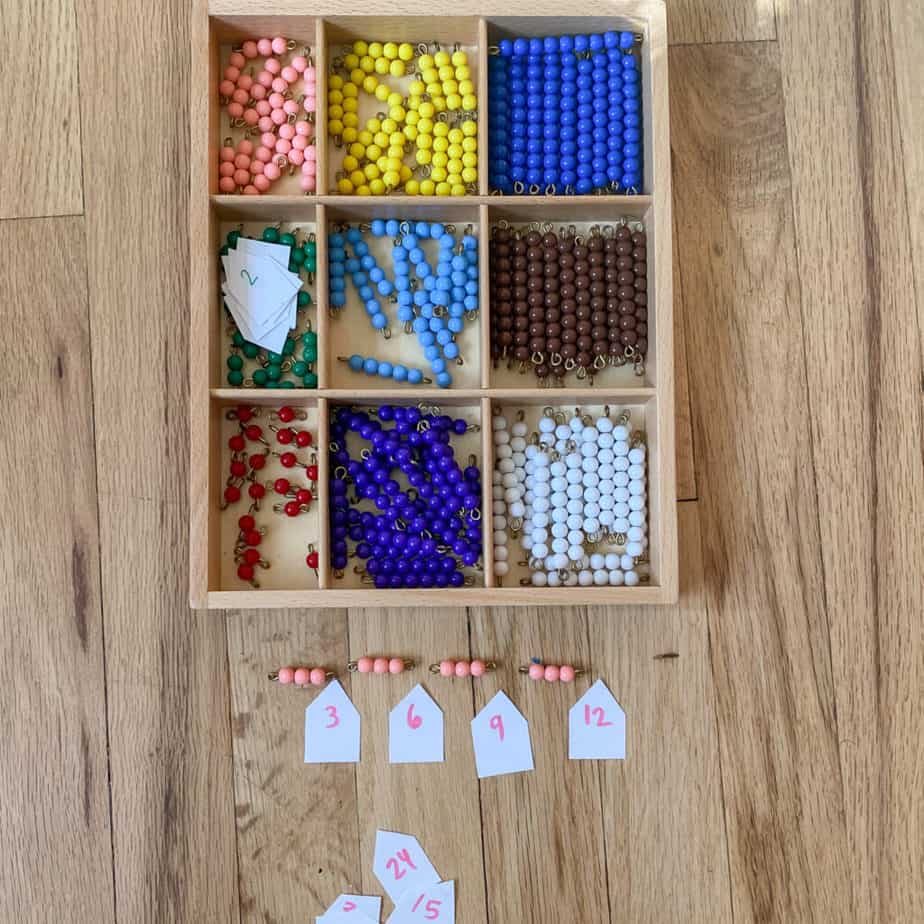
TIP – If the child is old enough to write the numbers, have him cut the index cards into strips one day and use the tune in his head to help him write one of the skip counting numbers on each strip. Say, “We’re going to use these for a new activity tomorrow!” and set it aside.
3. Abacus
I love this Learning Resources Abacus because of the way the 10s are divided into 5s with the yellow & blue beads.

In order for the abacus to work well for skip counting, you have to spend some time introducing your child to the abacus first. These articles can help you teach the abacus.
Once your child is familiar with the abacus, you can use it to practice skip counting. The child can choose a song to sing and pull the beads over in groups. Or you can turn it into a simple game:
- Write the numbers 1-12 on index cards, shuffle them, and place the set of cards face-down in a pile.
- Have the child turn over the top card and sing that song while pulling the beads over on the abacus in equal groups.
4. Count Around the House
This one is as simple as it sounds. Start pointing out things around your home (or out and about) that can be counted in skip counting sequences. Seeing groups in real life really helps the concept of skip counting sink in.
For example, we used to have window panes in rows of 3. Our kids would skip count by 3s. Then, my daughter figured out she could just skip count the whole window by 12s to figure out how many panes there were total. This actually led to her trying to figure out the entire house 🙂
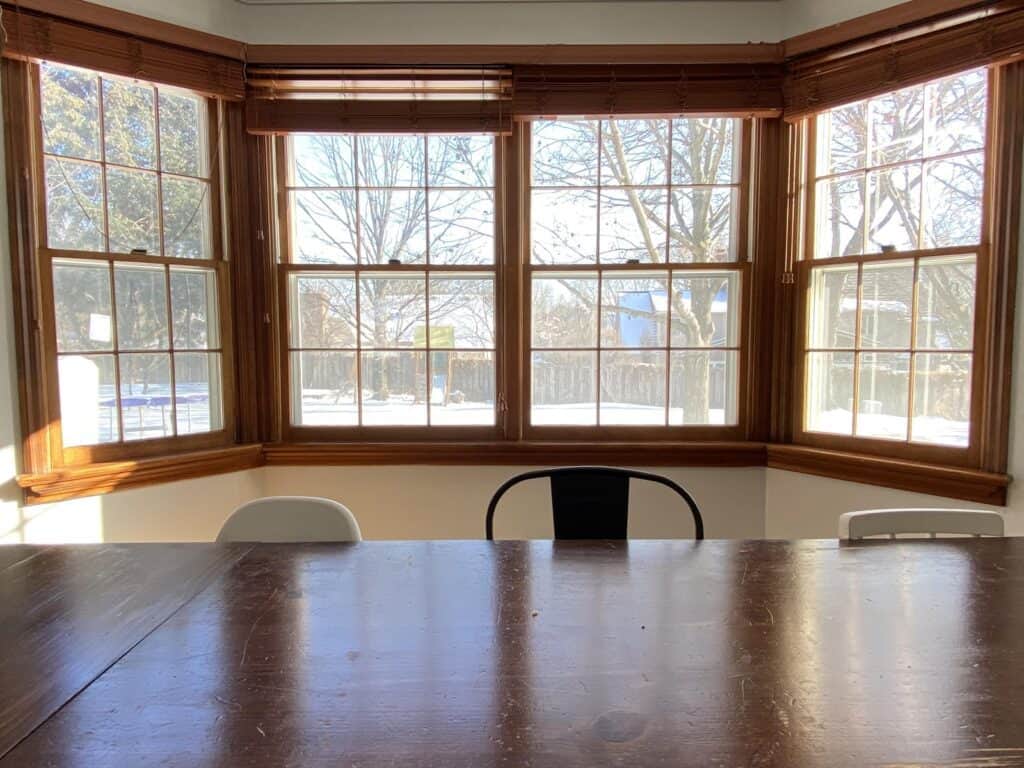
5. Flashcards that visualize equal groups
We created flashcards to download with our songs that perfectly visualize counting in equal groups. You can download them digitally and show them on your device or print them off so the child can handle them more easily.
We prefer printing on card stock & laminating for durability.
You can demonstrate touching each box while you sing the song the child knows. Or if you’re listening for the first time, pull them out and point while you listen.
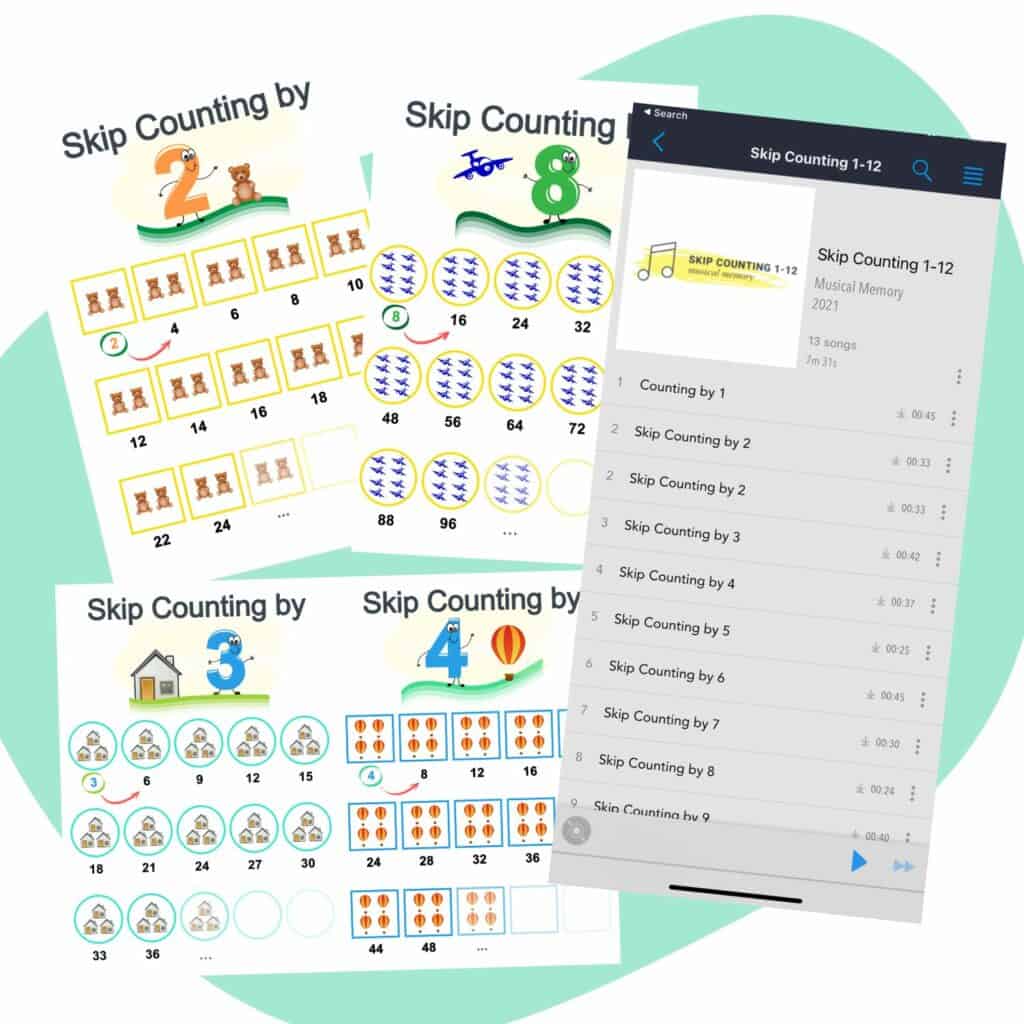
6. Paper Clips on a Plate
Again, the concrete visual representation of equal groups is important in the early years when a child is first learning how skip counting translates to actual math operations.
Placing paper clips on the rim of a paper plate can help a child internalize the concept of counting in equal groups.
The picture below shows groups of 5 – they put 5 paper clips together, then wrote 5. Then, they put 5 more and wrote 10. Then, they put 5 more and wrote 15. All the way up to 40. You could do more than one plate if you want to count up to 60 (like our songs) or up to 100! If you have several children, you could have one child pick up where the other child left off and see how high you can get.
TIP – Some kids will find this type of activity tedious. Skip it! That goes for any of the activities on here. I’m a firm believer in no busy-work for homeschooling. So, a child who finds this paper clip activity to be boring will likely enjoy the efficiency of using the Abacus or Montessori Beads. Go with what works best for your kiddo.
7. Paper Clip Chains
You can arrange the paper clips however you want. The bottom right image shows groups of 3 by colors. All the other images show ways to arrange the paper clips with post-its labeling the numbers. Paper clip chains help create a solid foundation for skip counting and you can save the chains for future math games.

8. Dot Paints
This activity would be especially beneficial if your child is familiar with the 10 frame. If so, I’d use the free printables below with blank 10 frames. Have the child use a Q-Tip in paint OR some sort of Dot Paints to put one dot in each box.
If you’re counting by 6s, the paper would look like this:
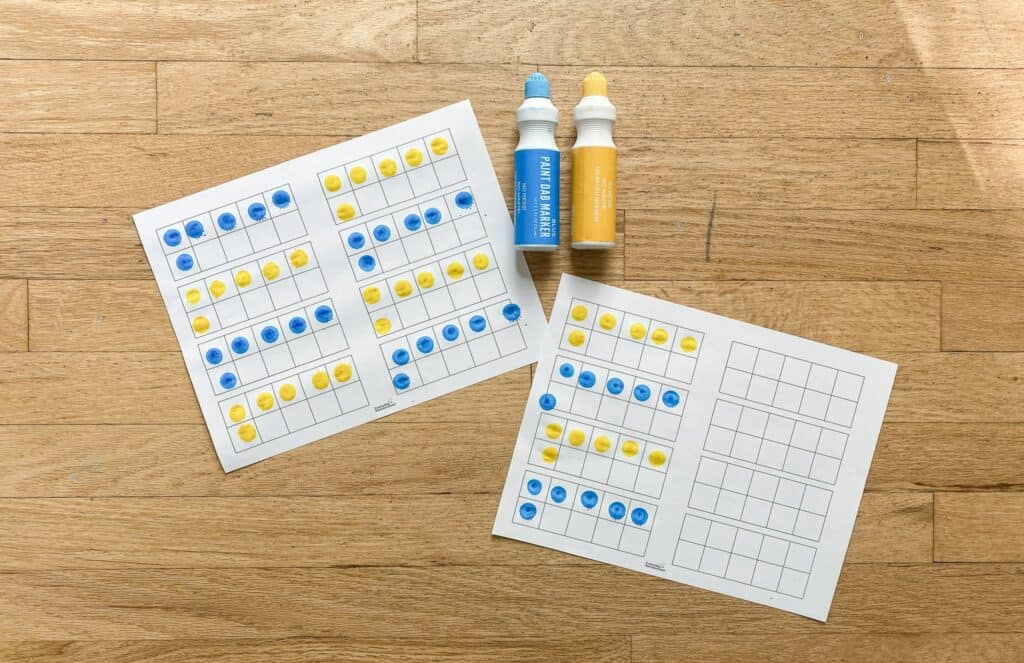
Here are the printable 10 frames in 2 different formats. Use whichever your child is already familiar with for now. You can always introduce the other one in the future.
Printable 10 Frames – 1 Row of 10
Printable 10 Frames – 2 Rows of 5
9. Tally Marks
If your child already knows how to tally, have them tally and skip count by 5s first.
Then add 3 tallies to each group and skip count by 8s… singing to your skip counting by 8s song.
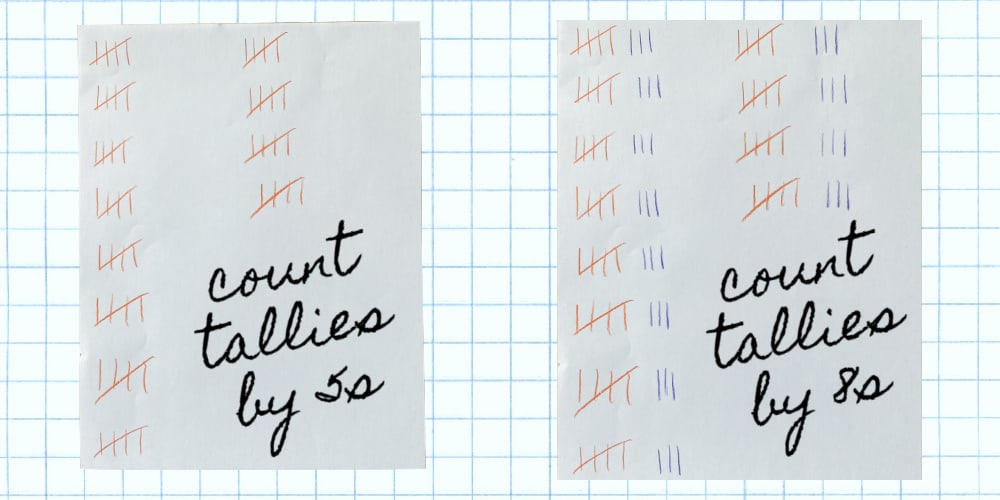
10. Giant Number Lines
Number Lines are an activity that bridges the gap between concrete and abstract.
Numbers represent actual objects. All the activities mentioned so far concretely depict quantities of objects.
By putting the numbers in order on a line, you are representing both the concrete quantity and the abstract concept of the number representing a quantity. Number lines are great for a child with developing number sense.
Number lines won’t work well for most 5-6 year olds, but by age 7 or so, the number line skip counting might make sense. (Think late 1st grade to early 2nd grade math curriculum.)
I buy these rolls of paper, which work great for all kinds of things, including a number line. You could also use this sheet to print off the numbers 1-150, cut apart the rows & tape the strips together. Or just write the numbers on regular blank paper strips and tape those together.
If your kids are developmentally able, they can help you write the numbers. If writing the numbers would take up too much time for them, the adult should write the number line BEFORE the lesson. Then, have the child do the color coded highlighting or circling!
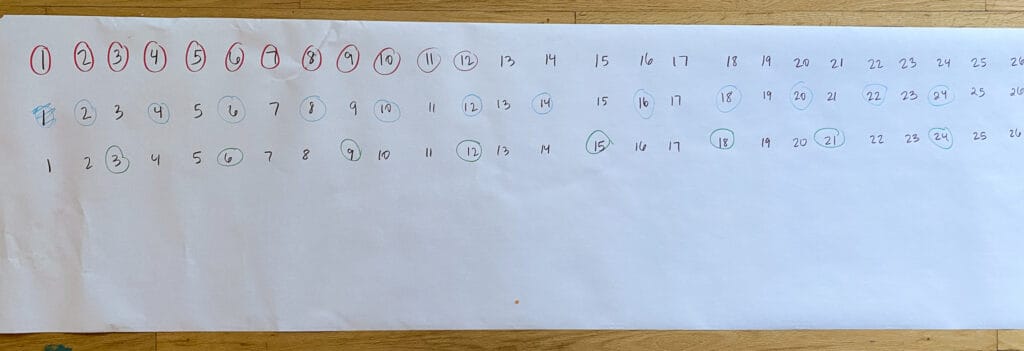


11. Finger Skip Counting
This works well if you have several people available. Have everyone hold up both hands in a line or a circle. If you’re going to skip count by 3, have everyone hold up 3 fingers on each hand.
Whoever starts slowly moves one hand and says “3,” then he moves the other hand and says “6.” The person next to him moves one hand and says, “9.” Then, he moves his next hand and says, “12.” This continues until you run out of fingers.
You can then come to conclusion: If we have 8 hands holding up 3 fingers each, there are 24 fingers! Repeat a few times, and try singing the coordinating skip counting song a little faster each time.
12. Dice
Traditional dice are a great visual for skip counting. Emphasize that you are counting DOTS (not dice).
Below, you’d count by 3s up to 36. “36 dots! on 12 dice with 3 dots each.”
Then, take a couple dice away and count by 3s again.

Worksheets & Abstract Skip Counting Practice
Once your child knows his skip counting songs by rote AND has practiced concrete skip counting of objects in equal groups, he can use this next set of activities to practice skip counting in a more abstract way.
These activities are more abstract in that they mostly do not visually show the quantity of objects. Rather, these activities assume that when the child is practicing counting 4-8-12-16, the child knows those numbers represent 4 objects, 8 objects, 12 objects, etc.
These types of worksheets are mostly best for kids after the age of 6 or 7.
13. Skip Counting Dot to Dots (Free)
This worksheet is a crowd favorite! I feel like all of our kids have loved doing these.
Even our brand new skip counting 5 year old loves to practice these while he sings. For a younger child, the dot-to-dot is just cementing the rote skip counting songs & number recognition. He doesn’t really internalize that the numbers he’s counting represent equal groups and 10 equal groups of 5 is 50 objects.
That’s okay. If the the 5 year old wants to use these dot-to-dots as fun kindergarten worksheets, that’s fine! Just remember, he’s probably not conceptually understanding much about equal groups. On the other hand, when he does get to the concept of counting in equal groups, he’ll likely pick it up immediately.
Here is a cute set of Under the Sea themed dot to dot skip counting printables. If you scroll all the way down on the post, you’ll find the link for a free download.
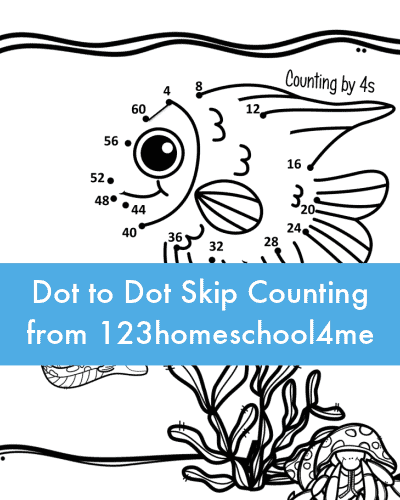
14. Skip Counting Mazes (Free)
Mazes serve a similar purpose to dot-to-dots… just a fun way to practice the rote counting & recognizing the next number in the skip counting sequence.
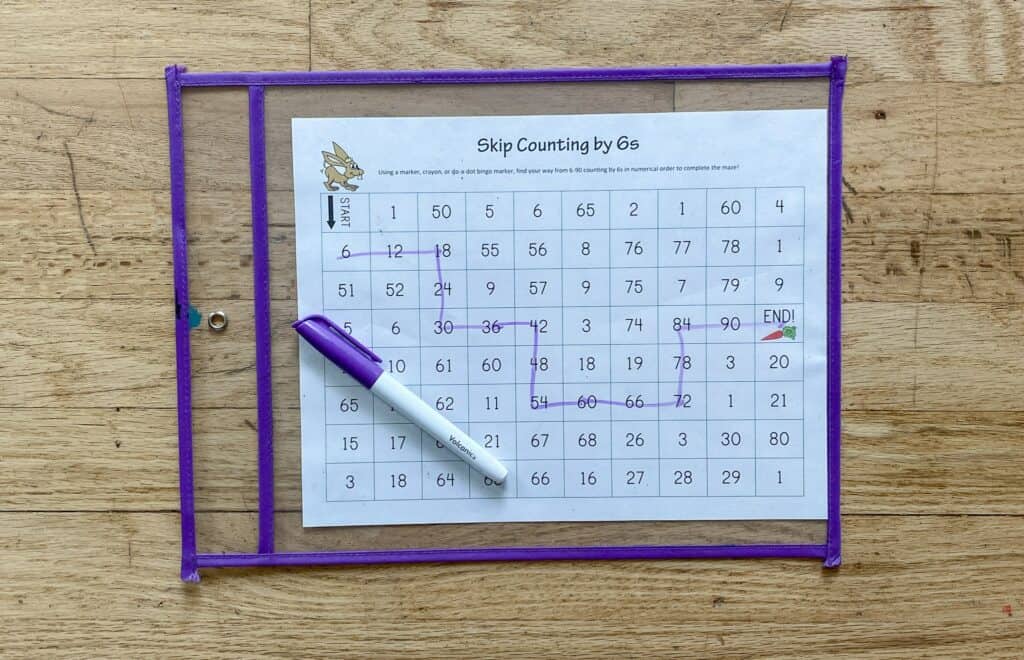
You can print them on paper and complete with dot-paint style markers, highlighters, crayons, paint sticks, or whatever you have on hand.
I also like putting any type of practice pages like this in a dry erase sleeve for multiple kiddos to work on. Plus it saves paper
15. Missing Numbers
I always just write this activity on a white board, but you could probably search for printable worksheets online if you prefer.

You can have the child figure out the skip counting pattern on their own, or you can say, “Skip count by 6s to fill in the blank.” Either way, they should fill in the empty slots with the correct number.
To modify, you can…
- Write several numbers on post it notes and have the child visually sift through the numbers to choose the correct ones.
- Hide the correct numbers on post-its around the room. Have the child hunt for them and put them in the correct spot.
16. Sticky Notes (3 Activities)
There are lots of things you could do with sticky notes for skip counting. Choose whichever is developmentally appropriate for your child.
- Write the numbers on various post-its. Have the child rearrange them put them up in the correct order on the wall. Another way to play this is to hide the post-its around the room first. Have the child find them and put them all in order on the wall.
- Cover up every 4th number on the hundred chart with a post-it or dot sticker and let the child sing the 4s song and pull off the stickies while they sing to check if they sang the correct answers. Then have the child put them back on while counting a different song.
- Draw a certain number of X’s on each post-it and then skip count the quantity of Xs. Repeat with various numbers. Use this activity to write multiplication problems. 6 post its with 4 Xs each creates the math equation 6 x 4 = 24. (This one is more concrete!)

17. Arrays and Dice
Print this grid paper. Have the child roll 2 10-sided dice or 12-sided dice. Show the child how this creates a skip counting problem… if the child rolls a 3 and a 6, they can count by 3s six times or by 6s three times. Either way, you get to 18. Show the child how they can color in the grid to be 3 rows of 6 or 6 rows of 3.
Either way, you get an array with 18 little boxes.
Repeat and try to fill in as much of the paper as possible.
This is a great way to practice multiplication facts if you have an older child too. They can think of the dice as creating a multiplication problem rather than a skip counting problem.
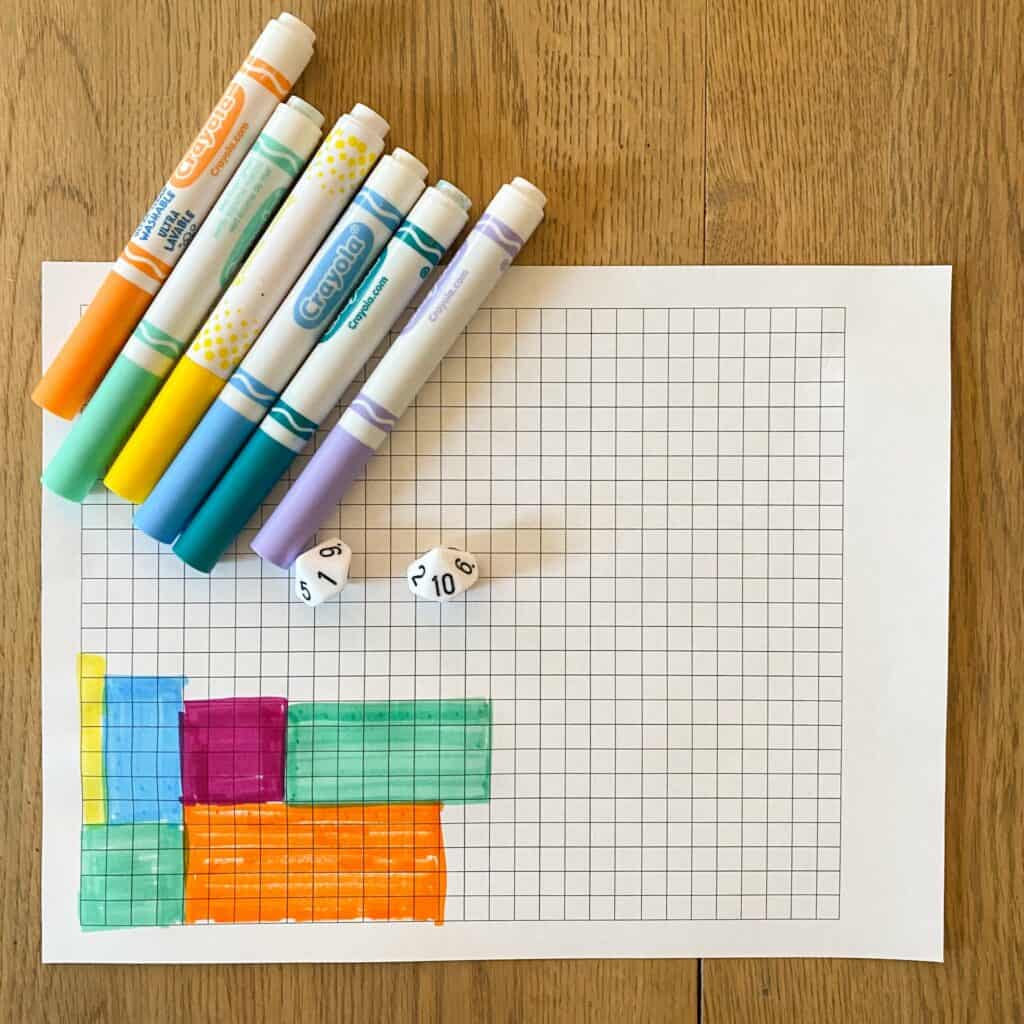
This would be a super fun option for math centers (or an independent math activity) for 1st or 2nd graders who like to be challenged.
18. Hundreds Chart Coloring
Print off a few pages of these hundreds charts. (Or print one and pop it in a dry erase sleeve. We use these dry erase sleeves in our homeschool all the time.)
Depending on how old your child is, you might only have them do 1 or 2 charts per day. For an older child, you can show them how to get started and have this be an independent math activity.
Tell them to color the numbers you get when counting by 2s up to 100. Repeat for counting by 3s, 4s, etc. This activity yields some fun visual patterns.
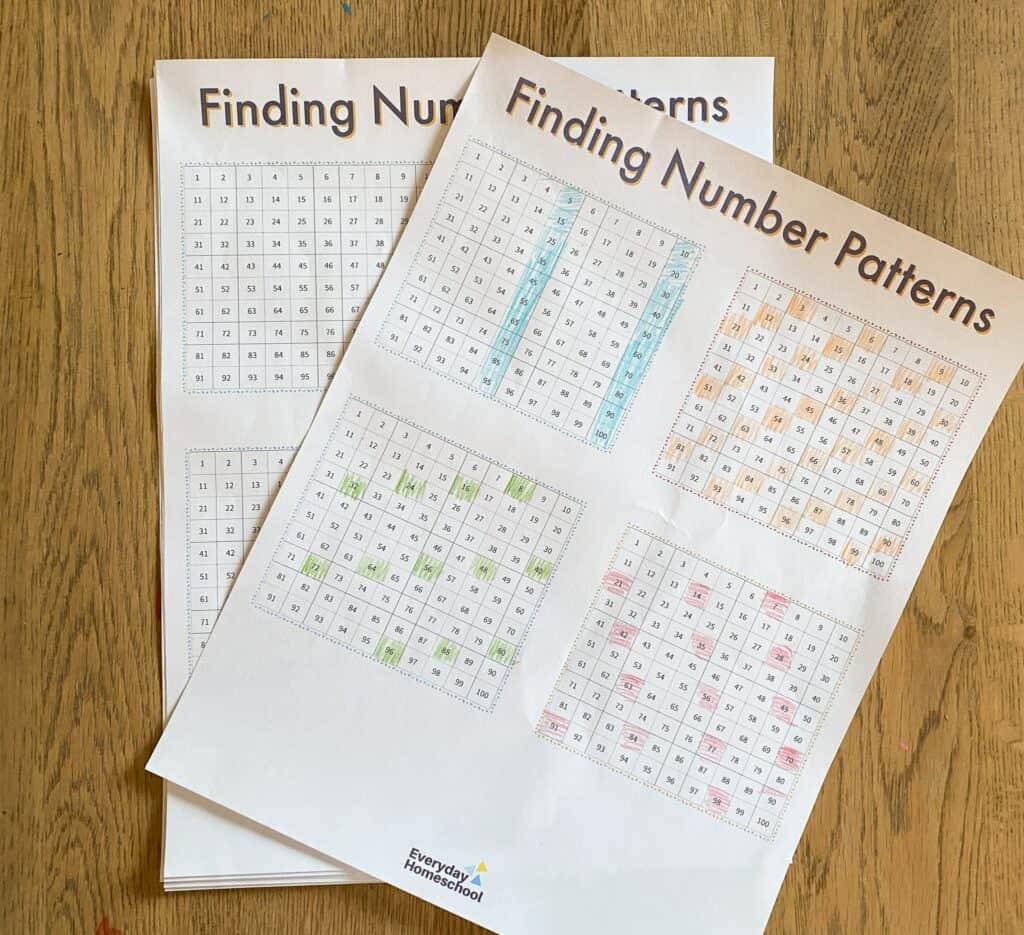
19. Sentence Strips as an Anchor Chart
This Reading Mama used sentence strips to create a rote counting chart! Simple & fun. Again, if you have young students, or if writing this many numbers neatly is too cumbersome, the adult should do the majority of the writing. If the child is able, the child could do the writing & you could use a ruler to keep the numbers evenly spaced.
Once you have the entire chart created, point out how you can count vertically or horizontally and the numbers line up! If the child is old enough, they could then create their own multiplication chart with empty boxes the same way.
Hands-On Skip Counting Activities
20. Wrap Ups
My kids love these multiplication wrap ups! They’re great extra practice for a child who has learned the skip counting songs and is starting to work on the concept of multiplication.
They’re a useful tool for kids who finish early or for extra practice during summer learning. My kiddos have loved this especially during second grade.
21. Lacing Plates
These are kind of a DIY version of the wrap ups. You can use both or just create these if you’re on a budget. Your child would probably enjoy creating 1 or 2 per week with you. Just put a dot where the child should do the hole punches.
Hole punching and lacing are different ways to practice fine motor skills too.
Here is what the finished product would look like – 123 Homeschool 4 Me has more details about how to make the plates.
22. Fly Swatter
We love using a fly swatter for random math & counting games. When you need to inject some extra fun into your math lessons, grab a flower shaped fly swatter from Amazon or the dollar store and turn your concept into a game. Here is one fly swatter game for practicing skip counting.
Choose a skip counting sequence to work on. Say you’re working on the 4s. Write each number in the 4s number sequence in a random spot on the board. Or use post-its. So you’d have each of the following written somewhere: 4, 8, 12, 16, 20, 24, 28, 32, 36, 40, 44, 48.

Fly swatters are fun for an entire class game too. They add a fun twist to free skip counting games and there are various ways you could use fly swatters in your classroom or homeschool.
For a kiddo in kindergarten or first grade, who is practicing the skip counting songs, just have him swat the stickies in order as they sing the song. He can even first move the stickies in the correct order and then swat them while singing.
For older kids, here’s a fun fly swatter game that will challenge students:
Call out a number 1-12. For example, number 7. If you’re practicing the 4s, they’d sing up to the 7th number in their head, and then swat 28. If they get it wrong, have them count on their fingers while skip counting.

By counting one finger at a time while skip counting, they can see that when they get to the 7th number in the 4s sequence, the answer is 28.
Then, call out the number 4. Have them count by 4s to the 4th number and swat the 16.
23. Hopscotch
If your student has a bunch of extra energy, head outside and create skip counting hopscotch games.
I saw this idea at Playdough to Plato. She mentioned that a bunch of neighbor kids tried it as they walked by too… so fun!

24. Roll the Dice – Actions!
I bought these large foam dice at the Dollar Store. Or you could order a giant inflatable one on Amazon.
Version #1 – working on a newer skip counting song
- Jot down a list of actions on a dry erase board that corresponded with a number 1-6. (The child can help you brainstorm for fun.)
- Choose a skip counting song to practice.
- The child rolls the dice and practices that skip counting song with the action they rolled.
- Roll again and have the child practice that song a few times with various actions.
Version #2 – Reviewing all the skip counting songs learned so far
- Shuffle a set of cards numbered 1-12. (Our number cards came with the math game, Tiny Polka Dot, but you can easily just make your own number cards on index cards. If you’re feeling like an over achiever, use colored cardstock & laminate them for future use.)
- Have the child roll the dice and draw a card.
- The card indicates which number song to sing & the dice indicates the action to do with the song.
- For the picture below, if the child drew the number 7 and rolled a 5, they’d sing the 7s song while jumping up and down.
25. Roll the Dice – Voices
This is the same counting game as above, but instead of an Actions List, create a Silly Voices List. Such an easy way to get the rote practice in.

26. Play Store with 2s, 5s, 10s, 25s
Playing store has to be one of the best math activities of all time. It’s a great way to practice a host of math skills at one time. Grab a roll of quarters, dimes, nickels & some 2 dollar bills from the bank.
You can print or make some for free, but I like having the real deal. So do the kids. We keep it all in a container in our math room & have been using the same coins and dollars for several years.
Grab a few items around your house and label them with a price on post-its. If your child is practicing nickels, make all the prices a multiple of 5 and have them only pay with nickels.
If your child is practicing with counting by 10s, make the price a multiple of 10 and have them pay only with dimes.
Use the same principle for 25s and 2 dollar bills. (We don’t have a 25s song, but we do chant “25-50-75-100” with a natural chant-sounding rhythm to learn counting for quarters.)
Your store can be super simple. Mine always looks like this. No fancy printables or pinterest-worthy displays required.

27. Skip Counting Books
This is probably one of my personal favorites because I love math books!! Here is our list of favorite math books for skip counting. Each of these books are a great visual representation of skip counting. (You can see the entire selection in one spot on my Amazon List here.)
- Arctic Fives Arrive
- Two of Everything
- Corkscrew Counts: A Story About Multiplication
- How Do You Count a Dozen Ducklings
- Two Ways to Count to Ten
- Spunky Monkeys on Parade
- Count on Pablo
- Remainder of One
- One Hundred Angry Ants
- Lots of LadyBugs
- How Many Feet in the Bed?
- The Grapes of Math
- Each Orange Has 8 Slices
28. Start on a random number
This is an oral counting activity that is good mental practice once your child already knows their skip counting songs. Have your child start on at a random place in the skip counting sequence and go up to the end.
Initially, the child may sing the song to get to the starting point so they know where in the tune they are. That’s okay!
For example, “Start on 24 and count to 72 by 6s.”
Child: 24, 30, 36, 42, 48, 54, 60, 66, 72
29. Counting backwards
This is another counting aloud activity. Have your child start at the end of a skip counting sequence and count to zero.
For example, “Start on 84 and count backwards by 7s.”
Child: “84, 77, 70, 63, 56, 49, 42, 35, 28, 21, 14, 7.”
30. Right Start Math Games
While I love many of the above-mentioned free skip counting games, I also absolutely love our Right Start Math Games Kit. You have to have the book & the activity box to play the games. There are 300 games for teaching all kinds of math concepts:
- addition & subtraction
- skip counting & more importantly cementing which numbers belong to which sets (i.e. 3, 6, 9, 12 belong to the threes; 4, 8, 12, 16 belong to the fours, etc…)
- multiplication & division
- time
- money
- fractions
and more!
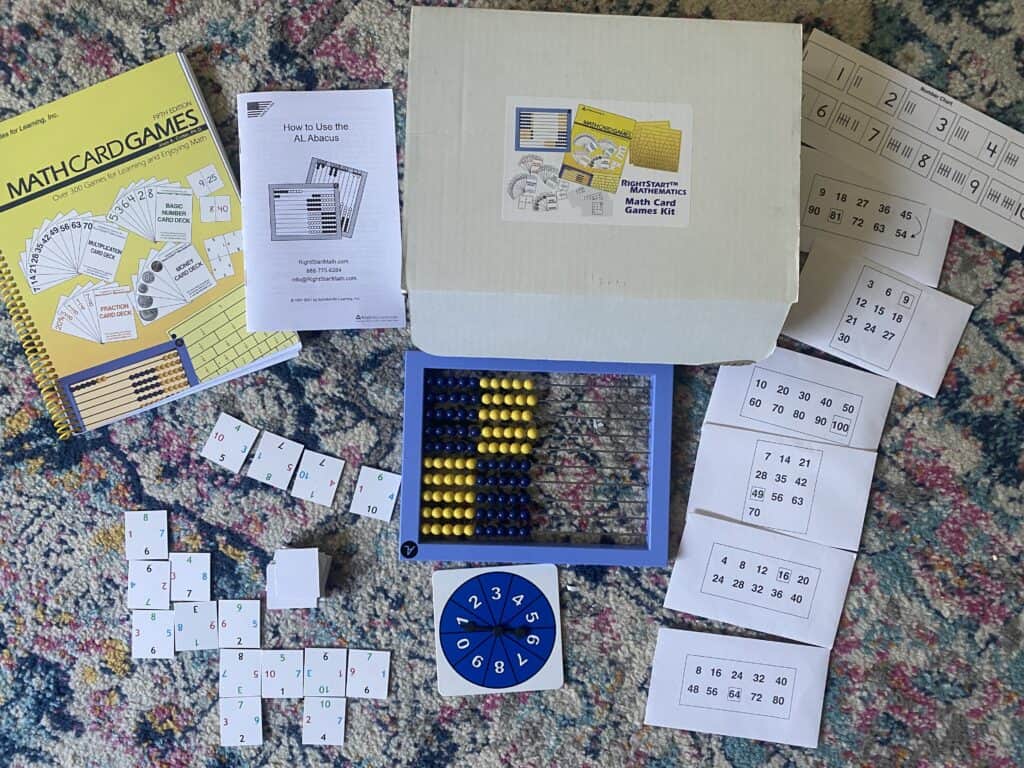
Want to know the 100% easiest way to teach skip counting?
Check this article out! It explains how simple skip counting songs are effective in terms of long-term conceptual understanding.
